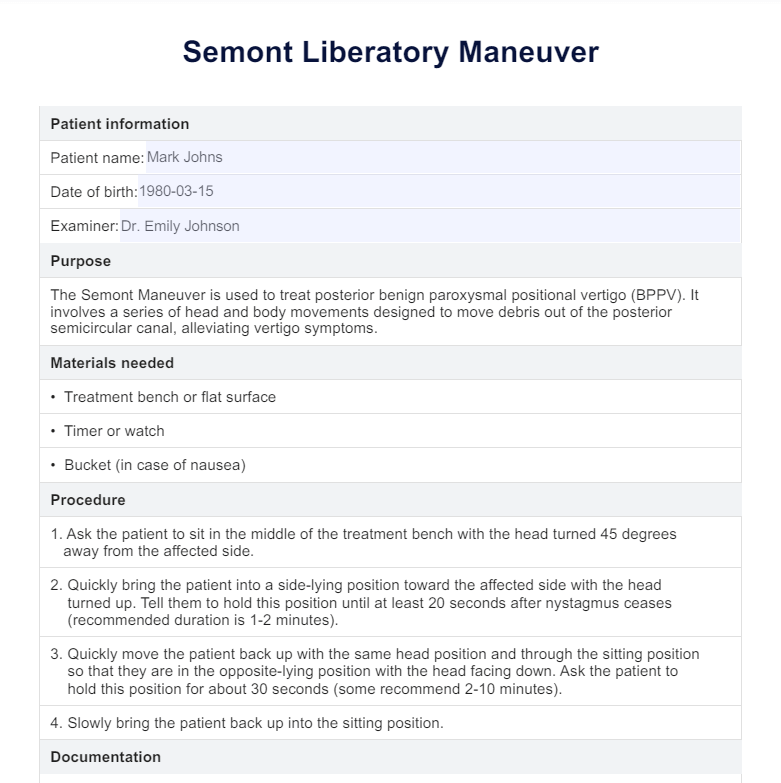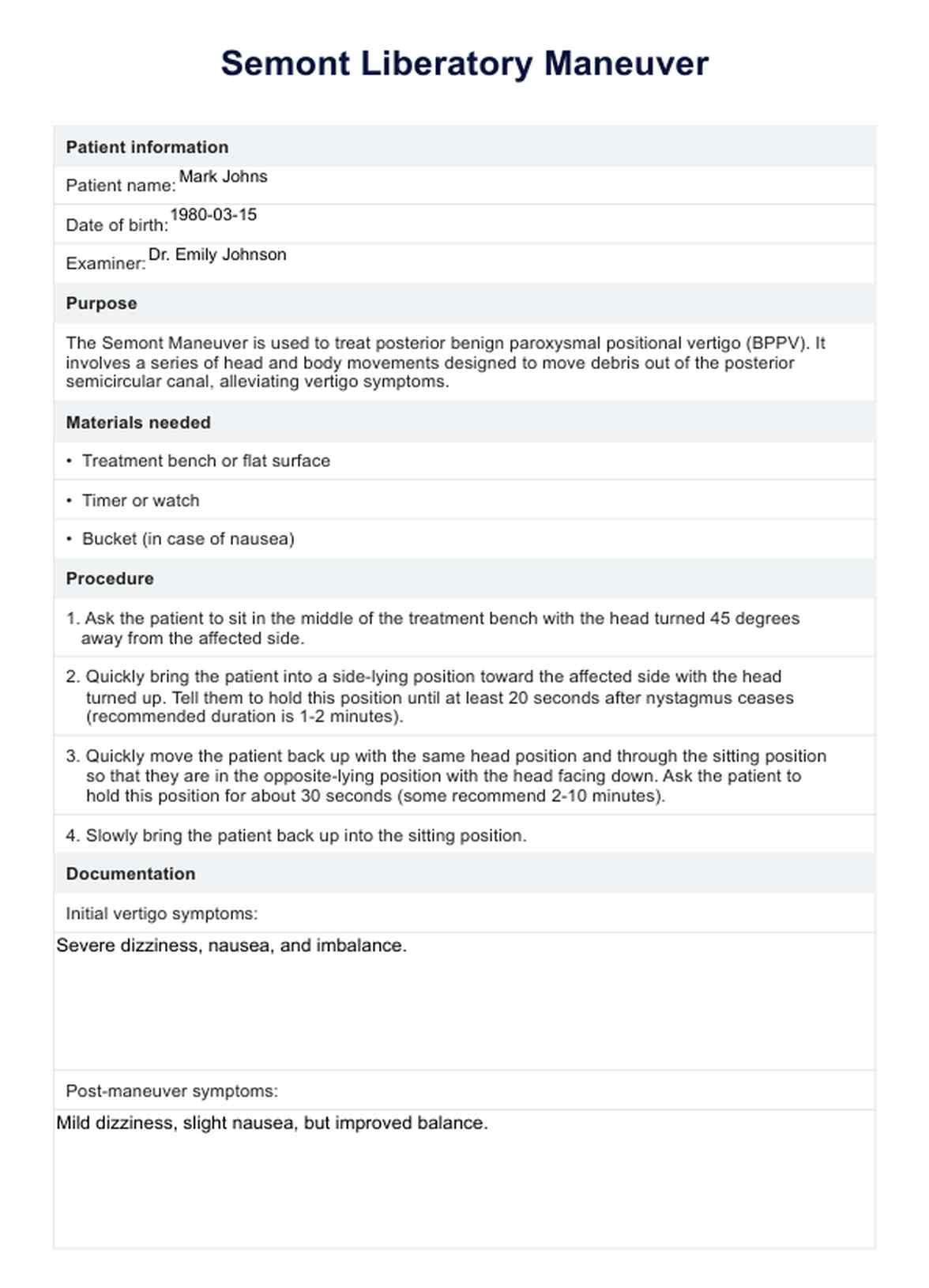Semont Liberatory Maneuver
Discover how to treat posterior BPPV with the Semont Liberatory Maneuver. Learn the benefits, step-by-step procedure, and why Carepatron is essential for physical therapists.


What is posterior benign paroxysmal positional vertigo?
Posterior canal benign paroxysmal positional vertigo (BPPV) is a common vestibular disorder characterized by brief episodes of vertigo triggered by changes in head position. This condition occurs when tiny calcium carbonate crystals (otoconia) become dislodged from their usual location in the utricle and migrate into one of the inner ear's semicircular canals, typically the posterior canal. The movement of these crystals disrupts the normal fluid dynamics within the canal, leading to the sensation of spinning or dizziness when the head is moved.
Symptoms of posterior BPPV
Posterior BPPV presents specific symptoms usually triggered by head movement or position changes. These include:
- Sudden, intense episodes of vertigo lasting less than a minute, often triggered by rolling over in bed, tilting the head back, or looking up.
- Nausea or vomiting associated with vertigo episodes.
- Imbalance or unsteadiness, particularly when walking.
- A sensation of the room spinning or moving, especially when lying down or getting up.
- Nystagmus, which is involuntary eye movement observed during vertigo episodes.
Causes of posterior BPPV
The exact cause of posterior BPPV is often unclear, but several factors are known to contribute to the development of this condition. These include:
- Head trauma, which can dislodge the otoconia from their usual location.
- Inner ear infections or labyrinthitis, which can affect the inner ear structures.
- Age-related degeneration of the vestibular system, increasing the likelihood of otoconia displacement.
- Prolonged bed rest or certain sleeping positions that may promote the movement of otoconia into the semicircular canals.
- Vestibular neuritis or other conditions that affect the inner ear balance system.
- Previous episodes of BPPV, which can increase the risk of recurrence.
Understanding the symptoms and causes of posterior BPPV is crucial for effective diagnosis and treatment. It allows healthcare professionals to provide targeted interventions to alleviate the condition and improve patient outcomes.
Semont Liberatory Maneuver Template
Semont Liberatory Maneuver Example
What is the Semont Liberatory Maneuver?
The Semont Liberatory Maneuver is a therapeutic technique to treat posterior benign paroxysmal positional vertigo, a common inner ear disorder that causes vertigo. This maneuver involves a series of rapid head and body movements to reposition dislodged calcium carbonate crystals (otoconia) from the posterior semicircular canal back to their correct location in the utricle, thereby alleviating the vertigo symptoms.
How do physical therapists perform this maneuver?
Physical therapists execute the Semont Liberatory Maneuver through targeted head and body movements to treat posterior BPPV. The patient begins seated upright on a treatment bench, with the therapist turning the patient's head 45 degrees away from the affected ear. The patient is then swiftly brought into a side-lying position on the affected side, with the whole head turned and facing upward. This position is held until vertigo and nystagmus subside, typically for 1 to 2 minutes.
Next, the therapist quickly transitions the patient from sitting to opposite side-lying, with the head facing downward. This position is held for about 30 seconds to 2 minutes. Finally, the patient is slowly returned to a sitting position.
These deliberate movements help relocate the dislodged otoconia from the posterior semicircular canal back into the utricle, relieving the vertigo symptoms associated with BPPV. This maneuver is effective and non-invasive and can significantly improve the patient's quality of life by reducing vertigo episodes.
How exactly does it help treat posterior BPPV?
The Semont Liberatory Maneuver helps treat posterior BPPV by using gravity and head movements to relocate the dislodged otoconia. The rapid transitions between head positions create a force that helps to dislodge and move the otoconia from the posterior semicircular canal into the utricle, where they can be reabsorbed or no longer cause symptoms. This repositioning reduces or eliminates the abnormal fluid movements in the semicircular canal, which are responsible for the sensation of vertigo.
Next steps after conducting this maneuver
After conducting the Semont Liberatory Maneuver, several follow-up steps are essential to ensure effective treatment and monitor patient progress:
- Observation and assessment: Observe the patient for any immediate relief or recurrence of symptoms. Assess for the presence of nystagmus or vertigo during head movements.
- Patient education: Educate the patient about the possibility of transient dizziness or nausea following the maneuver. Guide the patient through managing these symptoms and when to seek further medical attention.
- Follow-up appointments: Schedule follow-up appointments to monitor the patient's progress and determine if additional maneuvers are necessary. For persistent symptoms, multiple treatment sessions may be required.
- Home exercises: Provide the patient with home exercises to maintain the maneuver's benefits and prevent recurrence. These exercises often include simple head and body movements to keep the otoconia in place.
- Alternative treatments: If the Semont Maneuver is ineffective or symptoms persist, consider alternative treatments such as the Epley Maneuver or other vestibular rehabilitation exercises.
Regular follow-up and appropriate management are crucial to ensure long-term relief and improve the quality of life for patients with posterior BPPV.
How to use our Semont Liberatory Maneuver template
The Semont Liberatory Maneuver template is a practical tool designed to help healthcare professionals effectively document and perform the Semont maneuver for treating posterior benign paroxysmal positional vertigo. Follow these steps to utilize the template efficiently:
Step 1: Fill in patient information
Enter the patient’s full name, date of birth, date of examination, and the examiner’s name in the designated fields at the top of the template to ensure accurate record-keeping and identification.
Step 2: Review the purpose and anatomical background
Familiarize yourself with the purpose of the Semont Maneuver. This step provides essential context for why the maneuver is performed and enhances understanding of the treated condition.
Step 3: Prepare necessary materials and follow the test steps
Ensure you have all the required materials, including a treatment bench or flat surface, a timer or watch, and a bucket in case of nausea. Then, proceed with the test steps.
Step 4: Interpret and document results
Assess the reduction or elimination of vertigo symptoms post-maneuver. Record the initial and post-maneuver symptoms in the documentation section, noting any additional observations or follow-up recommendations. Recognize the potential for canal conversion from the posterior to the lateral semicircular canal, which may require further treatment.
Step 5: Complete and sign the template
Finalize the documentation by signing and dating the template at the bottom. This ensures that all information is recorded correctly and ready for future reference.
Benefits of conducting this maneuver
Conducting the Semont Liberatory Maneuver offers significant advantages for patients and healthcare professionals. This maneuver effectively treats posterior BPPV, providing quick relief from vertigo symptoms. Here are three key benefits of performing this maneuver:
Rapid symptom relief
The Semont Liberatory Maneuver provides rapid relief from the debilitating symptoms of posterior BPPV. This maneuver quickly alleviates vertigo, dizziness, and imbalance by repositioning the dislodged otoconia in the inner ear. Patients often experience immediate improvement, which enhances their quality of life and reduces the risk of falls and other complications associated with vertigo.
Non-invasive treatment
This maneuver is a non-invasive treatment option that does not require medication or surgery. It can be performed in a clinical setting without special equipment, making it a cost-effective and accessible option for treating BPPV. The simplicity and safety of the Semont Maneuver make it an attractive first-line treatment for healthcare professionals.
Improved patient outcomes
Regular use of the Semont Liberatory Maneuver has resulted in better long-term outcomes for patients with posterior BPPV. The procedure reduces the frequency and severity of vertigo episodes, allowing patients to return to their daily activities more confidently and stable. Additionally, it can be repeated if symptoms recur, providing a reliable method for managing chronic BPPV cases.
Commonly asked questions
Posterior paroxysmal positional vertigo (BPPV) is a common vestibular disorder caused by dislodged calcium crystals (otoconia) in the inner ear. It leads to episodes of vertigo, typically triggered by head position changes.
The Semont Liberatory Maneuver involves a series of rapid head and body movements to reposition the dislodged otoconia from the posterior semicircular canal back to the utricle. This helps alleviate vertigo symptoms by restoring normal fluid dynamics in the inner ear.
During the Semont Maneuver, patients may experience brief episodes of vertigo and nystagmus. The maneuver involves rapid movements, and patients are advised to follow their physical therapist*’s instructions closely for the best results.




